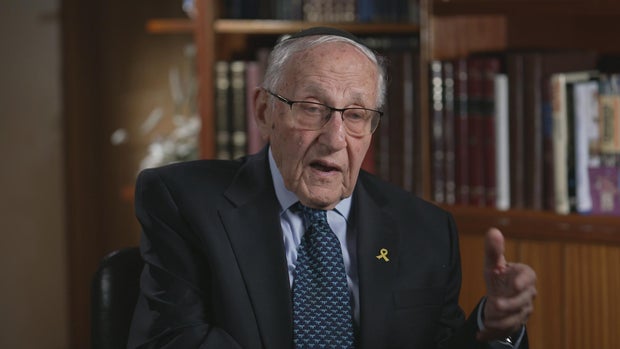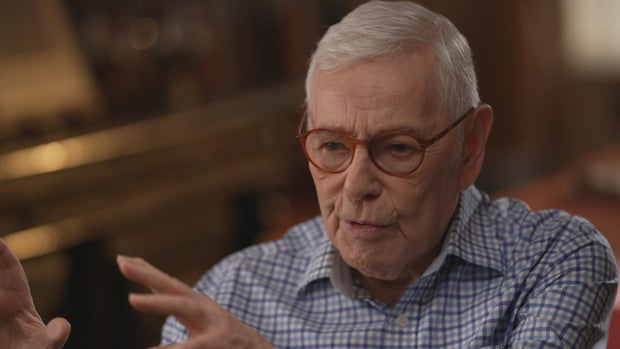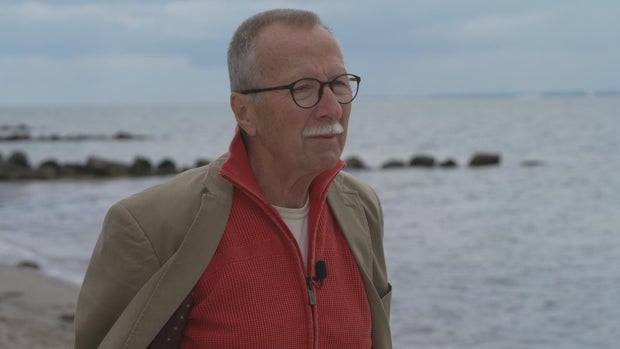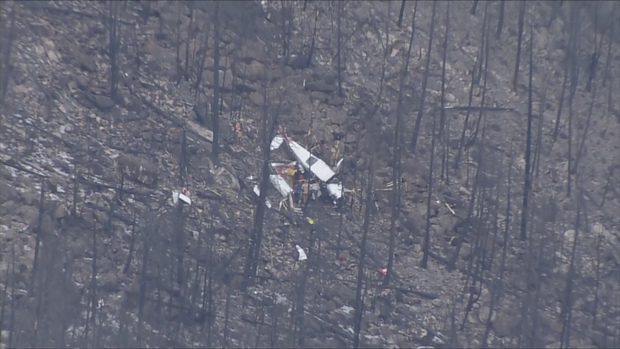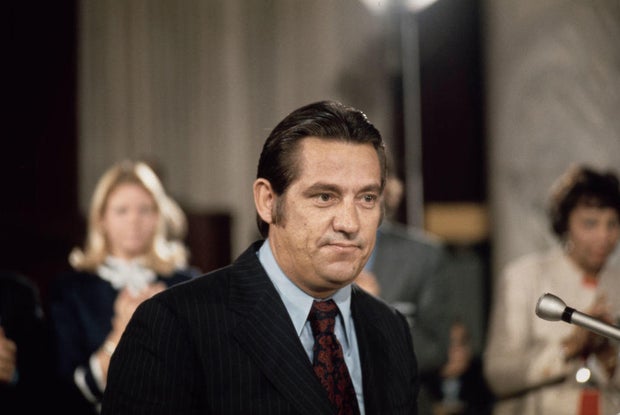CBS News
Holocaust survivors who witnessed the Cap Arcona bombing share their stories | 60 Minutes

During the Holocaust, Manfred Goldberg survived confinement in the Riga, Latvia ghetto and four concentration camps before he witnessed a bombing in Germany that took the lives of thousands of prisoners.
On May 3, 1945, just days before the end of World War II in Europe, British Royal Air Force planes mistakenly attacked the Cap Arcona ocean liner in Lübeck Bay in the Baltic Sea. The ship was crammed with thousands of concentration camp prisoners.
As the planes struck, Goldberg was at a nearby German naval base, lined up under SS guard with other prisoners.
“And it is while we stood there that we witnessed bombers and fighter planes coming along,” Goldberg said.
He remembers seeing the planes drop ordnance and hearing detonations.
“There were some pretty powerful explosions, and there were quite a few,” Goldberg said.
Before the war
Before World War II, the Cap Arcona was a German cruise ship for the well-to-do. For more than a decade after its 1927 launch, the ocean liner transported well-heeled passengers from Europe to South America in just two weeks. The ship had many luxuries, including a tennis court, a heated swimming pool and a restaurant with an ocean view, historian Bill Niven said.
The cruise ship traversed the Atlantic dozens of times. On one of its last trips before the war, the ocean liner carried some German Jewish passengers who had bought tickets to safety in South America.
In 1939, as German troops invaded Poland, the Nazis commandeered the Cap Arcona. It was repurposed into a floating barracks in the Baltic.
Who were the prisoners sent to the Cap Arcona
In 1945, as Allied forces closed in, the rusted and battered Cap Arcona was repositioned to the Nazi holdout at Lübeck Bay. At the same time, SS Chief Heinrich Himmler ordered the evacuation of concentration camps.
“I think the main concern was to get rid of evidence because prisoners are evidence,” Niven said. “They can talk. They can tell. They can speak to those atrocities that were committed by the Nazis. So getting rid of the evidence meant getting rid of human beings.”
Thousands of prisoners — Jews, Americans, Greeks and Italians among them — were sent to Lübeck Bay. The Cap Arcona arrived on April 14, 1945, two weeks before Nazi leader Adolf Hitler killed himself and three weeks before the end of the war in Europe. It was anchored about 2 miles offshore. With its engines barely running and little in the way of food and water, the once playground for the rich and famous was about to become a prisoner ship.
With nowhere to hold the amassed prisoners, SS guards jammed more than 4,000 of them onto the Cap Arcona.
“And one must remember this is a ship that’s meant for 1,500 people,” Niven said. “It’s not meant for 4 to 5,000 prisoners.”
Willi Neurath, a political prisoner, was among those forced on to the Cap Arcona. Neurath was not Jewish but he actively opposed the Nazi regime and was arrested for distributing anti-fascist fliers. He spent time in Buchenwald, and then the Neuengamme camp near Hamburg, before his Nazi captors sent him to Lübeck Bay.
60 Minutes
Jewish concentration camp prisoners George Schwab, Manfred Goldberg, and his mother Rosa were sent to Lübeck Bay from the Stutthof Camp in Nazi-occupied Poland.
Goldberg, now 94, was just 11 when the Nazis forcibly removed him and other Jews from his hometown of Kassel, in central Germany.
Schwab, now 92, was only 9 when German soldiers invaded his hometown of Liepāja, Latvia. The Nazis killed his father, a prominent physician, after he tried to protect other Jews in town.
The perilous journey to the Cap Arcona
From the Stutthof camp, Schwab and the Golbergs were put on barges. Packed with a thousand prisoners each, the barges were towed by tugboat for days until they reached Lübeck Bay.
Schwab remembers his time on the barge as “hell on Earth.” There were no bathrooms and hardly any food.
“You could hardly sit, you can certainly not sleep,” he said
60 Minutes
Many on the barges did not survive the journey to Lübeck Bay. Once there, the SS guards uncoupled the tugboats, leaving the prisoners adrift.
George Schwab and Manfred Goldberg said that on the barges were prisoners of war, who were better fed and better treated than the concentration camp survivors, and seized the opportunity.
Goldberg said they pried floorboards loose and turned them into makeshift oars. Norwegian prisoners aboard Schwab’s barge used blankets to make sails, taking advantage of the wind.
Once the barges reached shore, Schwab and the Goldbergs found the strength to climb out, only to be intercepted by the SS and German troops, who shot and killed many prisoners on the spot.
“And we felt practically certain that we would be shot next,” Goldberg said. “But instead they lined us up into a column.”
The Goldbergs and Schwab were taken to the nearby naval base, where they witnessed bombers fly overhead.
Why the Royal Air Force bombed the ship
The Cap Arcona was hit at approximately 3 p.m. In a hard-to-believe turn of events, the attackers were British Typhoons, part of the Allied forces moving in to finish off the Nazis. They’d come to liberate prisoners and ended up mistakenly killing thousands of them.
“You can imagine the panic and the horror that broke out when the bombs hit the ship,” Niven said, “especially for those concentration camp prisoners who were on the very lower decks of the ship. And they were unable to get up– to the top because of the flames.”
Sebastian Cox is chief historian for the Royal Air Force. He says the attack is “quite probably” the worst case of friendly fire in RAF history. He blames the incident on the fog of war.
“[The Allies believed] there was going to be an attempt to flee by certain Nazi elements across the Baltic to Norway,” Cox said, “and essentially continue the war.”
Cox said the pilots had no idea that concentration camp survivors were on the Cap Arcona. But other members of the British military did know, said Daniel Long, who wrote his Ph.D. history thesis on the Cap Arcona attack.
Long showed 60 Minutes what he said is the only official investigation into the tragic bombing. The report was completed in 1945 and is now held at the British National Archives in London. Shortly after Germany surrendered, a British war crimes investigator interviewed the intelligence officer for the squadrons that attacked the Cap Arcona and other ships in the bay.
60 Minutes
Long said that according to the report, the intelligence officer admitted a message was received on May 2, 1945 that the ships had been loaded with concentration camp prisoners.
That information, which came in the day before the Cap Arcona was attacked, never made it to the pilots, Long said. The report does not say why the intelligence officer failed to inform the pilots but it blamed Royal Air Force personnel for the error and called for further inquiry.
Cox said he is not aware of any follow-up investigation ever taking place, but he said it would “in many respects, be a little pointless.”
“We know what happened. The RAF made a mistake. An individual made a very tragic mistake,” Cox said. “And we know the consequences.”
The Cap Arcona’s survivors
About 7,000 prisoners perished when the Cap Arcona and a smaller cargo ship were bombed in Lübeck Bay. Of the more than 4,000 prisoners on the Cap Arcona, only about 400 survived, including Neurath. He couldn’t swim, so he didn’t jump into the water to escape the burning ship, his son Neurath-Wilson said, adding: “Prisoners who jumped into the water were shot by the SS.”
When the British realized their mistake, they dispatched rescuers who plucked Neurath and others from the listing deck of the Cap Arcona and took them to shore. Neurath-Wilson’s mother Eva was working at the nearby naval base. When she saw the bombing, she was drawn to the beach.
Neurath-Wilson said, “She had only one hope: To know, ‘Where is my husband? Is he still living? And maybe my husband is on the ship.'”
60 Minutes
On the beach, Neurath-Wilson said Eva didn’t recognize her husband, until he called out “Muppel,” his nickname for her. The pair reunited and Neurath-Wilson now shares his parents’ story.
Schwab pulled inspiration from the horror. A native of Latvia, he moved to New York, earned a Ph.D. in political science, and had an illustrious career as an academic and peace broker. He was awarded Latvia’s highest state decoration for his work helping the country join NATO.
Goldberg and his mother settled in London. She passed away in 1961. Goldberg married and started a business and a family. In 2017, he returned to the Stutthof camp with the then-Duke and Duchess of Cambridge, William and Catherine. He has made it his life’s mission to share his story.
“I consider that part of my revenge on the Nazis. They wanted to exterminate us. And here we are, not only having survived,” Goldberg said. “We are now great-grandparents.”
The Cap Arcona lay half-sunken in Lübeck Bay for four years before being dismantled. But the story has lain beneath the surface, little known beyond the Baltic Coast. It’s now tradition on the third of May for families of victims and survivors to sail to the site where the ship was bombed. They want the world to remember.
CBS News
2 killed in U.S. Civil Air Patrol plane crash near Palisade Mountain in Northern Colorado

Two people were killed and a third was injured when a U.S. Civil Air Patrol plane crashed in Colorado’s Front Range Saturday morning.
The small passenger plane with three people aboard crashed near Storm Mountain and Palisade Mountain west of Loveland around 11:15 a.m., according to the Larimer County Sheriff’s Office. The plane belonged to the Civil Air Patrol, the civilian auxiliary wing of the U.S. Air Force, and was on a routine aerial photography training mission when it went down, officials said.
Pilot Susan Wolber and aerial photographer Jay Rhoten were identified by CAP as those killed and co-pilot Randall Settergren was identified as the person injured. Settergren was airlifted to an area hospital by a National Guard helicopter, where he is undergoing medical care.
CBS
“The volunteers of Civil Air Patrol are a valuable part of the Department of Military and Veterans Affairs, and the lifesaving work they do on a daily basis directly contributes to the public safety of Coloradans throughout the state,” Maj. Gen. Laura Clellan, adjutant general of the Colorado Department of Military and Veterans Affairs, said in a statement Saturday.
“We are devastated to hear of the loss of Susan Wolber and Jay Rhoten, and the injury of Randall Settergren, during a training mission in Larimer County. Our thoughts and deepest condolences are with the families of those involved in the crash,” Clellan continued. “I would also like to thank all of the first responders who assisted with rescue efforts.”
Palisade Mountain is in Larimer County, about 20 miles west of Loveland and about 65 miles northwest of Denver. The area is part of the burn scar of the Alexander Mountain Fire, which burned almost 10,000 acres in over two weeks this past summer.
The crash happened about 200 feet below the summit of Palisade Mountain in an area that includes tall trees and steep hills as part of the mountain range. Rescue crews were heard on radio traffic working to find a landing zone for rescue helicopters. No structures were impacted by the crash.
The plane crashed in “very rugged” and “extensive and rocky terrain,” Ali Adams, a Larimer County Sheriff’s Office spokeswoman, said at a news conference. First responders had to hike out to the site and the sole survivor was “severely injured” when responders finally got to them.
Rescue efforts were ongoing at 3:15 p.m., according to Adams, and recovery efforts for the two deceased people’s bodies could take several days.
Several agencies responded, including the Loveland Fire Rescue Authority, Thompson Valley EMS and the National Guard.
The Larimer County Sheriff’s Office is the lead agency investigating the crash and the Federal Aviation Administration and National Transportation Safety Board will assist, according to Adams. The NTSB said it too was investigating the crash and identified the plane as a Cessna 182.
“This is one of those incidents that is really low frequency; it doesn’t happen really often, but unfortunately, our first responders have had more than their fair share of responses,” Adams said.
George Solheim lives in the area of the crash. He described conditions as “extremely windy” on Saturday and heard the plane just prior to the crash. He says he could hear “loud ‘throttle up/down’ immediately prior to sudden silence at (the) time of (the) crash. Couldn’t hear sounds of impact from here.”
Colorado Gov. Jared Polis extended his sympathy to the families of the victims in a statement Saturday evening:
“I’m saddened to hear of the loss of two dedicated Civil Air Patrol members, Pilot Susan Wolber and aerial photographer Jay Rhoten, who lost their lives in today’s crash and my thoughts are with their families, friends and colleagues. These individuals, along with survivor co-pilot Randall Settergren, who was injured, served the Civil Air Patrol as volunteers who wanted to help make Colorado a better, safer place for all. The State of Colorado is grateful for their commitment to service and it will not be forgotten. I also want to thank the first responders who assisted with the rescue and recovery efforts.”
CBS News
Fred Harris, former Democratic U.S. senator and presidential candidate, dies at 94

Fred Harris, a former U.S. senator from Oklahoma, presidential hopeful and populist who championed Democratic Party reforms in the turbulent 1960s, died Saturday. He was 94.
Harris’ wife, Margaret Elliston, confirmed his death to The Associated Press. He had lived in New Mexico since 1976.
“Fred Harris passed peacefully early this morning of natural causes. He was 94. He was a wonderful and beloved man. His memory is a blessing,” Elliston said in a text message.
Bettmann Archive/Getty Images
Harris served eight years in the Senate, first winning in 1964 to fill a vacancy, and made unsuccessful bid for the presidency in 1976.
“I am deeply saddened to learn of the passing of my longtime friend Fred Harris today,” Democratic New Mexico Gov. Michelle Lujan Grisham wrote in a post to social media. “Harris was a towering presence in politics and in academia, and his work over many decades improved New Mexico and the nation. He will be greatly missed.”
Democratic Sen. Martin Heinrich of New Mexico said in a statement that “New Mexico and our nation have lost a giant,” describing him as a “tireless champion of civil rights, tribal sovereignty and working families.”
It fell to Harris, as chairman of the Democratic National Committee in 1969 and 1970, to help heal the party’s wounds from the tumultuous national convention in 1968 when protesters and police clashed in Chicago.
He ushered in rule changes that led to more women and minorities as convention delegates and in leadership positions.
“I think it’s worked wonderfully,” Harris recalled in 2004, when he was a delegate to the Democratic National Convention in Boston. “It’s made the selection much more legitimate and democratic.”
“The Democratic Party was not democratic, and many of the delegations were pretty much boss-controlled or -dominated. And in the South, there was terrible discrimination against African Americans,” he said.
Harris ran unsuccessfully for the Democratic presidential nomination in 1976, quitting after poor showings in early contests, including a fourth-place win in New Hampshire. The more moderate Jimmy Carter went on to win the presidency.
Harris moved to New Mexico that year and became a political science professor at the University of New Mexico. He wrote and edited more than a dozen books, mostly on politics and Congress. In 1999 he broadened his writings with a mystery set in Depression-era Oklahoma.
Throughout his political career, Harris was a leading liberal voice for civil rights and anti-poverty programs to help minorities and the disadvantaged. Along with his first wife, LaDonna, a Comanche, he also was active in Native American issues.
“I’ve always called myself a populist or progressive,” Harris said in a 1998 interview. “I’m against concentrated power. I don’t like the power of money in politics. I think we ought to have programs for the middle class and working class.”
“Today ‘populism’ is often a dirty word because of how certain leaders wield power,” Heinrich said in his statement Saturday. “But Fred represented a different brand of populism — one that was never mean or exclusionary. Instead, Fred focused his work and attention on regular people who are often overlooked by the political class.”
Harris was a member of the National Advisory Commission on Civil Disorders, the so-called Kerner Commission, appointed by then-President Lyndon Johnson to investigate the urban riots of the late 1960s.
The commission’s groundbreaking report in 1968 declared, “our nation is moving toward two societies, one black, one white — separate and unequal.”
Thirty years later, Harris co-wrote a report that concluded the commission’s “prophecy has come to pass.”
“The rich are getting richer, the poor are getting poorer and minorities are suffering disproportionately,” said the report by Harris and Lynn A. Curtis, president of the Milton S. Eisenhower Foundation, which continued the work of the commission.
Norman Ornstein of the American Enterprise Institute said Harris rose to prominence in Congress as a “fiery populist.”
“That resonates with people…the notion of the average person against the elite,” Ornstein said. “Fred Harris had a real ability to articulate those concerns, particularly of the downtrodden.”
In 1968, Harris served as co-chairman of the presidential campaign of then-Vice President Hubert Humphrey. He and others pressed Humphrey to use the convention to break with Johnson on the Vietnam War. But Humphrey waited to do so until late in the campaign, and narrowly lost to Republican Richard Nixon.
“That was the worst year of my life, ’68. We had Dr. Martin Luther King killed. We had my Senate seatmate Robert Kennedy killed and then we had this terrible convention,” Harris said in 1996.
“I left the convention — because of the terrible disorders and the way they had been handled and the failure to adopt a new peace platform — really downhearted.”
After assuming the Democratic Party leadership post, Harris appointed commissions that recommended reforms in the procedures for selecting delegates and presidential nominees. While lauding the greater openness and diversity, he said there had been a side effect: “It’s much to the good. But the one result of it is that conventions today are ratifying conventions. So it’s hard to make them interesting.”
“My own thought is they ought to be shortened to a couple of days. But they are still worth having, I think, as a way to adopt a platform, as a kind of pep rally, as a way to get people together in a kind of coalition-building,” he said.
Harris was born Nov. 13, 1930, in a two-room farmhouse near Walters, in southwestern Oklahoma, about 15 miles from the Texas line. The home had no electricity, indoor toilet or running water.
At age 5 he was working on the farm and received 10 cents a day to drive a horse in circles to supply power for a hay bailer.
He worked part-time as a janitor and printer’s assistant to help for his education at University of Oklahoma. He earned a bachelor’s degree in 1952, majoring in political science and history. He received a law degree from the University of Oklahoma in 1954, and then moved to Lawton to practice.
In 1956, he won election to the Oklahoma state Senate and served for eight years. In 1964, he launched his career in national politics in the race to replace Sen. Robert S. Kerr, who died in January 1963.
Harris won the Democratic nomination in a runoff election against J. Howard Edmondson, who left the governorship to fill Kerr’s vacancy until the next election. In the general election, Harris defeated an Oklahoma sports legend — Charles “Bud” Wilkinson, who had coached OU football for 17 years.
Harris won a six-year term in 1966 but left the Senate in 1972 when there were doubts that he, as a left-leaning Democrat, could win reelection.
Harris married his high school sweetheart, LaDonna Vita Crawford, in 1949, and had three children, Kathryn, Byron and Laura. After the couple divorced, Harris married Margaret Elliston in 1983. A complete list of survivors was not immediately available Saturday.
CBS News
Compromise deal reached at COP29 climate talks for $300 billion a year to poor nations

Countries agreed on a deal to inject at least $300 billion annually in humanity’s fight against climate change, aimed at helping poor nations cope with the ravages of global warming at tense United Nations climate talks in the city where industry first tapped oil.
The $300 billion will go to developing countries who need the cash to wean themselves off the coal, oil and gas that causes the globe to overheat, adapt to future warming and pay for the damage caused by climate change’s extreme weather. It’s not near the full amount of $1.3 trillion that developing countries were asking for, but it’s three times the $100 billion a year deal from 2009 that is expiring. Delegations said this deal is headed in the right direction, with hopes that more money flows in the future.
“Everybody is committed to having an agreement,” Fiji delegation chief Biman Prasad said as the deal was being finalized. “They are not necessarily happy about everything, but the bottom line is everybody wants a good agreement.”
It’s also a critical step toward helping countries on the receiving end create more ambitious targets to limit or cut emissions of heat-trapping gases that are due early next year. It’s part of the plan to keep cutting pollution with new targets every five years, which the world agreed to at the U.N. talks in Paris in 2015.
The Paris agreement set the system of regular ratcheting up climate fighting ambition as away to keep warming under 1.5 degrees Celsius above pre-industrial levels. The world is already at 1.3 degrees Celsius and carbon emissions keep rising.
Countries also anticipate that this deal will send signals that help drive funding from other sources, like multilateral development banks and private sources. That was always part of the discussion at these talks — rich countries didn’t think it was realistic to only rely on public funding sources — but poor countries worried that if the money came in loans instead of grants, it would send them sliding further backward into debt that they already struggle with.
“The $300 billion goal is not enough, but is an important down payment toward a safer, more equitable future,” said World Resources Institute President Ani Dasgupta. “This deal gets us off the starting block. Now the race is on to raise much more climate finance from a range of public and private sources, putting the whole financial system to work behind developing countries’ transitions.”
It’s more than the $250 billion that was on the table in the first draft of the text, which outraged many countries and led to a period of frustration and stalling over the final hours of the summit. After an initial proposal of $250 billion a year was soundly rejected, the Azerbaijan presidency brewed up a new rough draft of $300 billion, that was never formally presented, but also dismissed roundly by African nations and small island states, according to messages relayed from inside.
The several different texts adopted early Sunday morning included a vague but not specific reference to last year’s Global Stocktake approved in Dubai. Last year there was a battle about first-of-its-kind language on getting rid of the oil, coal and natural gas, but instead it called for a transition away from fossil fuels. The latest talks only referred to the Dubai deal, but did not explicitly repeat the call for a transition away from fossil fuels.
Countries also agreed on the adoption of Article 6, creating markets to trade carbon pollution rights, an idea that was set up as part of the 2015 Paris Agreement to help nations work together to reduce climate-causing pollution. Part of that was a system of carbon credits, allowing nations to put planet-warming gasses in the air if they offset emissions elsewhere. Supporters said a U.N.-backed market could generate up to an additional $250 billion a year in climate financial aid.
Despite its approval, carbon markets remain a contentious plan because many experts say the new rules adopted don’t prevent misuse, don’t work and give big polluters an excuse to continue spewing emissions.
“What they’ve done essentially is undermine the mandate to try to reach 1.5,” said Tamara Gilbertson, climate justice program coordinator with the Indigenous Environmental Network. Greenpeace’s An Lambrechts, called it a “climate scam” with many loopholes.
With this deal wrapped up as crews dismantle the temporary venue, many have eyes on next year’s climate talks in Belem, Brazil.


